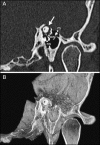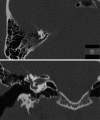Characteristics and management of superior semicircular canal dehiscence
- PMID: 24294552
- PMCID: PMC3578588
- DOI: 10.1055/s-0032-1324397
Characteristics and management of superior semicircular canal dehiscence
Abstract
Objectives To review the characteristic symptoms of superior semicircular canal dehiscence, testing and imaging of the disease, and the current treatment and surgical options. Results and Conclusions Symptoms of superior semicircular canal dehiscence (SSCD) include autophony, inner ear conductive hearing loss, Hennebert sign, and sound-induced episodic vertigo and disequilibrium (Tullio phenomenon), among others. Potential etiologies noted for canal dehiscence include possible developmental abnormalities, congenital defects, chronic otitis media with cholesteatoma, fibrous dysplasia, and high-riding jugular bulb. Computed tomography (CT), vestibular evoked myogenic potentials, Valsalva maneuvers, and certain auditory testing may prove useful in the detection and evaluation of dehiscence syndrome. Multislice temporal bone CT examinations are normally performed with fine-cut (0.5- to 0.6-mm) collimation reformatted to the plane of the superior canal such that images are parallel and orthogonal to the plane. For the successful alleviation of auditory and vestibular symptoms, a bony dehiscence can be surgically resurfaced, plugged, or capped through a middle fossa craniotomy or the transmastoid approach. SSCD should only be surgically treated in patients who exhibit clinical manifestations.
Keywords: Tullio phenomenon; autophony; hearing loss; superior semicircular canal dehiscence syndrome; vertigo.
Figures





Similar articles
-
Clinical Characteristics of Posterior and Lateral Semicircular Canal Dehiscence.J Neurol Surg B Skull Base. 2015 Dec;76(6):421-5. doi: 10.1055/s-0035-1551667. Epub 2015 May 29. J Neurol Surg B Skull Base. 2015. PMID: 26682120 Free PMC article.
-
Variety of audiologic manifestations in patients with superior semicircular canal dehiscence.Otol Neurotol. 2010 Jan;31(1):2-10. doi: 10.1097/mao.0b013e3181bc35ce. Otol Neurotol. 2010. PMID: 20050265
-
Incidence of intraoperative hearing loss during middle cranial fossa approach for repair of superior semicircular canal dehiscence.J Clin Neurosci. 2018 Aug;54:109-112. doi: 10.1016/j.jocn.2018.06.023. Epub 2018 Jun 13. J Clin Neurosci. 2018. PMID: 29908720
-
Superior semicircular canal dehiscence presenting as postpartum vertigo.Otol Neurotol. 2006 Sep;27(6):756-68. doi: 10.1097/01.mao.0000227894.27291.9f. Otol Neurotol. 2006. PMID: 16936563 Review.
-
Superior semicircular canal dehiscence: a narrative review.J Laryngol Otol. 2022 Apr;136(4):284-292. doi: 10.1017/S0022215121002826. Epub 2021 Oct 7. J Laryngol Otol. 2022. PMID: 34615564 Review.
Cited by
-
Computerized Assessment of Superior Semicircular Canal Dehiscence Size using Advanced Morphological Imaging Operators.J Neurol Surg B Skull Base. 2017 Apr;78(2):197-200. doi: 10.1055/s-0036-1594241. Epub 2016 Dec 7. J Neurol Surg B Skull Base. 2017. PMID: 28321386 Free PMC article.
-
Bilateral Superior Semicircular Canal Dehiscence Concurrent With Ehlers-Danlos Syndrome: A Case Report.Cureus. 2021 Nov 27;13(11):e19943. doi: 10.7759/cureus.19943. eCollection 2021 Nov. Cureus. 2021. PMID: 34984117 Free PMC article.
-
Transmastoid approach for resurfacing the superior semicircular canal dehiscence with a dumpling structure.Chin Med J (Engl). 2015 Jun 5;128(11):1490-5. doi: 10.4103/0366-6999.157657. Chin Med J (Engl). 2015. PMID: 26021506 Free PMC article.
-
Cochlear Aqueduct Morphology in Superior Canal Dehiscence Syndrome.Audiol Res. 2023 May 15;13(3):367-377. doi: 10.3390/audiolres13030032. Audiol Res. 2023. PMID: 37218843 Free PMC article.
-
Cross Sectional Imaging of the Ear and Temporal Bone.Head Neck Pathol. 2018 Sep;12(3):302-320. doi: 10.1007/s12105-018-0901-y. Epub 2018 Aug 1. Head Neck Pathol. 2018. PMID: 30069846 Free PMC article. Review.
References
-
- Chien W W, Carey J P, Minor L B. Canal dehiscence. Curr Opin Neurol. 2011;24:25–31. - PubMed
-
- Amoodi H A, Makki F M, McNeil M, Bance M. Transmastoid resurfacing of superior semicircular canal dehiscence. Laryngoscope. 2011;121:1117–1123. - PubMed
-
- Minor L B. Clinical manifestations of superior semicircular canal dehiscence. Laryngoscope. 2005;115:1717–1727. - PubMed
-
- Friedland D R, Michel M A. Cranial thickness in superior canal dehiscence syndrome: implications for canal resurfacing surgery. Otol Neurotol. 2006;27:346–354. - PubMed
-
- Minor L B, Carey J P, Cremer P D, Lustig L R, Streubel S O, Ruckenstein M J. Dehiscence of bone overlying the superior canal as a cause of apparent conductive hearing loss. Otol Neurotol. 2003;24:270–278. - PubMed
Publication types
Grants and funding
LinkOut - more resources
Full Text Sources

